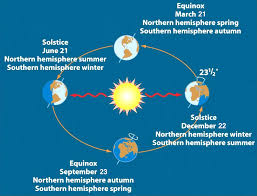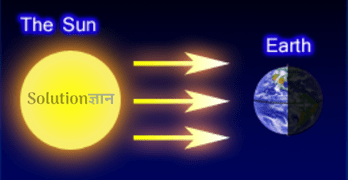DAV Class 6 SST Chapter 4 Question Answer The Motions of the Earth (Day-Night and Seasons) explores the exercises, given in the textbook “We and Our World Book”. These DAV Class 6 SST Solutions of The Motions of the Earth exercises provided at the end of the chapter 4 will be a useful resource for school exams.
Here at solutiongyan, we provide complete solutions of DAV Class 6 Social Science Geography Chapter 4 of We and Our World Book. The exercise of chapter 4 The Motions of the Earth (Day-Night and Seasons) contains 5 questions and the answers to them are provided in the DAV Class 6 SST Chapter 4 Question Answer.
Question Answer of DAV Class 6 Social Science geography help to boost the writing skills of the students, along with their logical reasoning. Students can go through Chapter 4 class 6 sst solutions to learn an effective way of expressing their answers in the exam.
Dav Class 6 SST Chapter 4 Geography The Motions of the Earth Solutions
DAV Class 6 SST Book Question Answer Chapter 4 The Motions of the Earth (Day-Night and Seasons) is given below. Here DAV Class 6 social science chapter 4 solutions is provided with great explanation.
Highlights
- Tick the correct option
- Fill in the blanks
- Match the following
- Answer the following questions in brief
- Answer the following questions
DAV Solutions For Class 6 SST of WE AND OUR WORLD Book is the best source for the students to self-analyse their performance. DAV Class 6 students are more likely to score good marks in the school exams if they practise Dav Class 6 SST Chapter 4 Question Answer regularly.
Dav Class 6 SST Chapter 4 Question Answer
A. Tick the correct option.
1. On 22nd December, the sun rays are vertical at the-
Answer: Tropic of Capricorn.
2. Which statement about a leap year is incorrect?
Answer: February has 28 days.
3. If there is noon on one side of the earth, the opposite side will have-
Answer: mid-night
4. On 23rd September, mid-day sun is overhead at the-
Answer: Equator
5. The angle of sun rays on 21st June on the Tropic of Cancer is-
Answer: 90°
B. Fill in the blanks.
1. The earth revolves around the sun in a fixed path called as ___________.
2. The angle of inclination of the earth’s axis is ___________ with its orbital plane.
3. Two motions of the earth are ___________ and ___________.
4. The time period immediate before sunrise is called ___________.
5. The earth completes one revolution around the sun in ___________ days and ___________ hours.
Answer: (1) orbit (2) 661/2° (3) rotation, revolution (4) dawn (5) 365, 6
C. Match the following:

Answer: (1) e, (2) c, (3) a, (4) b, (5) d.
D. Answer the following questions in brief.
1. What is rotation? How much time does earth take in completing one rotation?
Answer: The spinning of the earth on its axis from West to East is called rotation. It is daily motion of the earth. The Earth takes about 24 hours in completing one rotation.
2. What is meant by the revolution of the earth?
Answer: The motion of the earth is called revolution of the earth.
3. What is a leap year?
Answer: The month of February has 29 days instead of 28 days once in four years. That particular year is known as a Leap year.
4. What is an equinox? Which seasons are indicated by it in both the hemispheres?
Answer: After three months the revolving earth comes to this position. The sun shines vertically over the Equator. The days and nights are of equal duration in both the hemispheres on this date. Both the hemispheres receive the same amount of heat. This situation is called Equinox.
It is autumn season in the Northern Hemisphere and spring season in Southern Hemisphere.
5. Why does the duration of day and night change in a year?
Answer: The duration of the day and night changes in a year because the earth is tilted on its axis. As it orbits the Sun, a different part of the earth faces the Sun. When the hemispheres face the Sun, the length of the day is more than night. When the hemispheres are far away from the Sun, it is just the opposite. The nights are longer than days.
E. Answer the following questions.
1. Why are days and nights equal on 21st March at all places on the earth? Explain.
Answer: Days and nights are equal on 21st march at all places on the Earth because the sunrays are vertical over the equator. The duration of day and night becomes equal in both the hemispheres, i.e., 12 hours day and 12 hours night. Both the hemispheres receive equal amount of heat.
2. Explain with the help of a diagram, why seasons are reversed between Northern and Southern Hemispheres.
Answer: Diagram

1. Position of Earth on 21st June:
- Northern Hemisphere is inclined towards the sun thus experiences summer season which is called as summer solstice.
- Southern Hemisphere is away from the sun thus experiences winter season which is called as winter solstice.
2. Position of Earth on 23rd September:
Both the hemispheres receive same amount of heat and hence
- Northern hemisphere – Autumnal equinox
- Southern Hemisphere – Vernal Equinox
3. Position of Earth on 22nd December:
- Southern Hemisphere is inclined towards the sun thus experiences summer season which is called as summer solstice.
- Northern Hemisphere is away from the sun thus experiences winter season which is called as winter solstice.
4. Position of Earth on 21st March:
Both the hemispheres receive same amount of heat and hence
- Northern hemisphere – Vernal Equinox
- Southern Hemisphere – Autumnal Equinox
3. Why does the month of February have 29 days, after every four years? Explain.
Answer: The month of February has 29 days, after every 4 years because the earth completes one revolution in 365 days and about 6 hours. We consider 365 days in a year. The remaining 6 hours are added over a period of 4 years till they become 24 hours or one day. This extra day is added to the month of February every four years to make it a month of 29 days instead of 28 days.
4. How do day and night occur on the earth? Explain with the help of a diagram.
Answer: The earth completes one rotation in about 24 hours. So, the earth faces the sun while rotating from west to east. Each part of the earth facing the sun, is illuminated by sunlight turn by turn. The lighted half part of the earth that faces the sun has day. While the other part of the earth that is not facing the sun, experiences night.


It is very helpful without seeing the video an anything we can do our work so nice
You are Right.????
Tommorow is my exam and it helped me
The creator of this website is very helpful person.
Good ????????????????????????????????????
Before seeing this website, I thought brainly is best but in brainly I face some difficulty but, in this website, I cannot face any difficulty, but brainly can’t give any answer to questions. I give brainly 7/10 and solutiongyan9/10
Solution gyan is very useful for me . It helpen me a lot
The best website for education
This Gyan solution is best website because we don’t have to watch search any question!..if we will directly search “Gyan solution sst ch-4 so it will give you that whole chapter notes with back excercise!..really very grateful website!
It is very useful for DAV students studying in classes 6,7 and 8. Thank you for helping us.
It is a very useful website. It helps to do our homework. I will don’t forget this website.
I really can’t believe that for this website I became topper of the class .So salute to you ♥️♥️